土壤磷素储存容量(Soil Phosphorus Storage Capacity,SPSC)是指在土壤磷素达到环境淋失风险阈值前,土壤可继续容纳的外源磷的数量[1]。SPSC = 0是判断土壤是磷源或磷汇的临界阈值,也是判断土壤磷素是否具有淋失风险的转折点; 当SPSC > 0时,土壤是磷汇且可继续容纳外源磷; 当SPSC < 0时,土壤是磷源且不能继续容纳外源磷,此时的土壤极易向周围环境释放磷[2]。SPSC是基于磷饱和度(Degree of Phosphorus Saturation,DPS)概念提出并发展的指标,首次用磷饱和率(Phosphorus Saturation Ratio,PSR)代替了DPS对SPSC进行计算,使得SPSC的计算值可以直接评估与预测土壤磷素饱和状态及流失风险[3]。DPS由土壤中可提取态磷与饱和系数α及可提取态铁铝和的摩尔比计算得到,而PSR是忽略了DPS计算中较难确定的饱和系数α后的计算结果,由PSR计算得到的SPSC有效弥补了DPS无法估算土壤磷素安全储量的缺陷[3]。土壤在完全磷饱和之前,溶液中最接近环境阈值的磷水平,称为土壤PSR阈值[4],即Threshold PSR,可以由土壤PSR与CaCl2-P的相关曲线的“拐点(change point)”确定。PSR阈值的取值直接决定着SPSC计算结果的准确性,已有研究确定的PSR阈值的取值范围为0.08~0.23[5-7],而PSR阈值= 0.10应用最为广泛[8-9]。国外许多学者已经利用SPSC来对土壤磷素环境风险进行评价,并基于SPSC-DPS理论建立了土壤磷素的最佳管理模式[2, 4, 10, 11]。而国内对SPSC的应用与发展仍显不足,尤其是在铁铝氧化物含量丰富、固磷能力强、土壤结构性较差的红壤上的研究仍显不足。
红壤是我国南方地区最主要的土壤类型及粮食生产基地,外源磷肥的长期施入与磷肥的当季利用率低下,导致了红壤中磷素的过量累积; 降雨和径流的冲刷作用又极易导致红壤中富集磷通过地表径流和壤中流汇入水体,进而引起水体环境污染[12-13]。团聚体是土壤磷素固存与释放、周转与流失的重要载体而团聚体粒级的大小及分布比例又将影响着土壤磷素的储存与供应效能[14],进而调控着SPSC值的大小。因此,本研究以长期施肥(1988-)的红壤旱地为材料,以各粒级团聚体为载体,分析长期施肥条件下红壤旱地及各粒级团聚体的SPSC变化特征,探讨土壤全磷(TP)及速效磷(Bray-P)与SPSC的相关关系,基于SPSC值估算红壤旱地及大小团聚体磷的流失风险及其可继续容纳外源磷的“安全寿命”。研究结果可为红壤区土壤磷素资源管理、土壤磷素储存潜能的准确评估与农业高效、环境友好的磷素资源管理策略的制定提供理论依据。
1 材料与方法 1.1 试验概况长期试验地于1988年建在江西省鹰潭农田生态系统国家野外研究站院内(28°04′-28°37′N,116°41′-117°09′E)。1995年以前试验地进行花生和油菜轮作,后改为一季花生,冬季休田。供试土壤为第四纪红黏土发育的典型红壤。试验分无机肥区与有机无机肥配施区,其中无机肥试验区设:NPK、NP、PK、NK、NPKCa、NPKCaS共6个肥料处理(Ca表示施用石灰,S表示施用微量元素); 有机无机肥配施区设:对照(CK,约为1/2NPK肥)、1/2NPK+花生秸秆本田还田(PS)、1/2NPK+稻秆(RS)、1/2NPK+鲜萝卜菜(FR)、1/2NPK+猪厩肥(PM)共5个肥料处理; 每个肥料处理重复3次,每个小区的具体肥料用量参见文献[14]。
1.2 土壤样品采集与制备2014年秋季(花生收获2个月后),在每个实验小区用硬质饭盒采集原状土5点,密封好后,带回室内。同时,在每个试验小区内按“S”形,采集耕层(0~15 cm)土壤样品10~15点,去除小石块、植物残体以及动物遗体,混合均匀后、采用四分法保留1 kg左右,放于硬质密封盒中,带回室内自然风干,保存备用。
1.3 土壤团聚体筛分在原状土壤样品风干的过程中,用手沿着土壤的自然结构面轻轻将土壤样品剥成直径约10~12 mm大小的样块。风干后,称取20 g土壤样品放入套筛中(从上到下筛孔的直径依次为2 mm、1 mm、0.25 mm和0.053 mm),将套筛放入DX-100团聚体分析仪中,加水至淹没上层筛子土壤2 cm,浸泡10 min后,上下筛分30 min(频率为60次·min-1),然后取出套筛,自上而下的将各个筛子中的土壤颗粒转移至已知重量的铝盒中,放入40℃的烘箱中烘干、称重,即分别获得粒级为 > 2 mm、2~1 mm、1~0.25 mm与0.25~0.053 mm的团聚体样本。
1.4 土壤磷素储存容量(SPSC)的测定称取1.00 g过2 mm筛的风干土,置于100 mL的三角瓶中,加入50 mL 0.2 mol·L-1的草酸铵提取液(pH = 3.0),用橡皮塞将瓶口塞紧后装入里红外黑布袋以防止光化学反应,在室温(25℃±2℃)条件下震荡2 h后,离心、过0.45 μm滤膜。使用电感耦合等离子光谱仪(ICP)测定提取液中的铁(Feox)、铝(Alox)及磷(Pox)含量。分别按式(1)和式(2)计算得到磷饱和率(PSR)与SPSC:
| $ {\text{PSR = }}\frac{{{{\text{P}}_{{\text{OX}}}}}}{{{\text{F}}{{\text{e}}_{{\text{OX}}}}{\text{ + A}}{{\text{l}}_{{\text{OX}}}}}} $ | (1) |
| $ \begin{gathered} {\text{SPSC(mg}} \cdot {\text{k}}{{\text{g}}^{{\text{ - 1}}}}{\text{) = (Threshold}}\;{\text{PSR - Soil}}\;{\text{PSR) }} \times \hfill \\ {\text{(F}}{{\text{e}}_{{\text{OX}}}}{\text{ + A}}{{\text{l}}_{{\text{OX}}}}{\text{)}} \times {\text{31}} \hfill \\ \end{gathered} $ | (2) |
式中,Pox、Feox、Alox为草酸铵提取态磷、铁、铝的量(mmol·kg-1)。Threshold PSR为PSR的临界阈值,本研究中取值为0.10;Soil PSR为使用草酸铵溶液作为提取剂所测定的土壤的PSR值。
同时,根据式(3)计算各粒级团聚体对全土SPSC值的贡献率(Cr):
| $ {{\text{C}}_{\text{r}}}{\text{(% ) = }}\frac{{{\text{SPS}}{{\text{C}}_{{\text{aggregate}}}} \times {{\text{P}}_{{\text{aggregate}}}}}}{{{\text{SPS}}{{\text{C}}_{{\text{sum}}}}}} \times 100 $ | (3) |
式中,SPSCaggregate为某粒级团聚体SPSC(mg·kg-1); Paggregate为该粒级团聚体的所占比例(%); SPSCsum为各粒级团聚体SPSC的加和(mg·kg-1)。
1.5 土壤基本理化性质分析土壤有机质(OM)采用高温外热重铬酸钾氧化-容量法测定; pH采用电位法测定,液土比为2.5:1。土壤全磷(TP)采用硫酸-高氯酸(H2SO4- HClO4)消煮,土壤速效磷(Bray-P)采用盐酸-氟化铵法浸提,水溶性磷(CaCl2-P)采用0.01 mol·L-1 CaCl2溶液浸提,液土比为10:1,用钼蓝比色法测定上述浸提溶液中的磷浓度。上述指标测定的具体操作方法参见文献[15]。供试土壤基本理化性质见表 1。
|
|
表 1 供试土壤基本理化性质 Table 1 Basic physical and chemical properties of the red soil in the experiment |
数据统计分析采用Excel与SPSS 20.0软件; 绘图采用Origin 2017软件。
2 结果 2.1 长期施肥对红壤旱地SPSC的影响长期施肥可以显著影响红壤旱地SPSC的大小,无机肥区,长期不施磷肥的NK处理SPSC高达265 mg·kg-1,显著高于其他处理,分别是NPK、NP、PK、NPKCa和NPKCaS处理的1.9倍、1.6倍、1.9倍、2.0倍和2.4倍(图 1)。有机无机肥配施区,与CK处理相比,只有配施猪厩肥的PM处理可以显著降低红壤旱地SPSC,且SPSC为负值(-333 mg·kg-1),而PS、RS及FR处理的SPSC均为正值,且影响差异不显著(图 1)。

|
无相同字母表示处理间差异显著(P < 0.05)。 Note:Different letters mean significant difference between treatments at 0.05 level. 图 1 长期施肥对红壤旱地SPSC的影响 Fig. 1 Effect of long-term fertilizers on the SPSC in the upland red soil |
长期施用无机肥的红壤旱地中各粒级团聚体SPSC由高到低依次为1~0.25 mm、0.25~0.053 mm、> 2 mm、2~1 mm。与NK处理相比,NPK、NP、PK、NPKCa和NPKCaS处理中0.25~0.053 mm粒级团聚体SPSC分别显著降低了51%、37%、46%、58%及63%,1~0.25 mm粒级团聚体SPSC分别显著降低了51%、40%、56%、55%及64%;其中,NPKCaS处理中2~1 mm粒级团聚体与NP处理中 > 2 mm粒级团聚体的SPSC分别显著降低了62%及32%(图 2)。

|
无相同小写字母表示同一团聚体粒径不同肥料处理间差异显著(P < 0.05); 无相同大写字母表示同一肥料处理中不同粒级团聚体间差异显著(P < 0.05)。下同。 Note:Mean values affixed with the same lower-case letters are not significantly different at P < 0.05 between treatments the same in aggregate particle size. Mean values affixed with the same upper-case letters are not significantly different at P < 0.05 between aggregates different in particle size in the same fertilizer treatment. The same below. 图 2 长期施肥对红壤旱地各粒级团聚体SPSC的影响 Fig. 2 Effect of long-term fertilization on SPSC in aggregates in the upland red soil relative to particle size |
长期施用有机无机配施肥的红壤旱地中(PM处理除外)各粒级团聚体SPSC由高到低依次为1~0.25 mm、> 2 mm、0.25~0.053 mm、2~1 mm。与CK处理相比,仅PM处理可以显著降低各粒级团聚体的SPSC,且均呈现负值,而PS、RS及FR三个处理无显著影响(图 2)。
2.3 长期施肥条件下各粒级团聚体对红壤旱地SPSC的影响长期施用无机肥的红壤旱地中,各粒级团聚体对红壤旱地SPSC的贡献率由高到低依次为1~0.25 mm(55.3%~65.9%)、0.25~0.053 mm(16.9%~20.6%)、> 2 mm(7.2%~18.3%)、2~1 mm(7.3%~9.0%)(图 3)。与NK处理相比,NPK、NP、PK、NPKCa和NPKCaS处理的0.25~0.053 mm及2~1 mm粒级团聚体对土壤SPSC的贡献率无显著变化; PK处理中1~0.25 mm粒级团聚体对红壤旱地SPSC贡献率显著降低了16%;而PK、NPKCa和NPKCaS处理中 > 2 mm粒级团聚体对红壤旱地SPSC贡献率显著增加了1.3倍、1.4倍和1.6倍(图 3)。
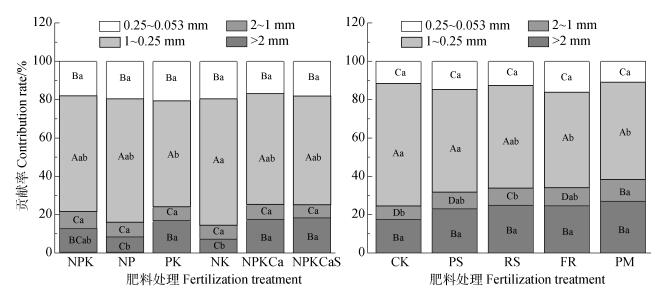
|
图 3 长期施肥对红壤旱地各粒级团聚体SPSC的贡献率 Fig. 3 Effect of long-term fertilization on SPSC contribution rate of aggregates in the upland red soil relative to particle size |
长期有机无机肥配施的红壤旱地中,各粒级团聚体对红壤旱地SPSC的贡献率由高到低依次为1~0.25 mm(47.3%~63.9)、> 2 mm(17.4%~27.0%)、0.25~0.053 mm(10.9%~16.1%)、2~1 mm(7.2%~11.4%)(图 3)。与CK处理相比,PS、RS、FR、PM处理的0.25~0.053 mm及 > 2 mm粒级团聚体对SPSC的贡献率无显著变化; FR和PM处理中1~0.25 mm粒级团聚体对红壤旱地SPSC的贡献率显著降低了22%及21%;而PM处理中2~1 mm粒级团聚体对红壤旱地SPSC贡献率显著增加了0.6倍(图 3)。
2.4 土壤供磷水平对红壤旱地SPSC的影响土壤磷素供应状况是影响红壤旱地SPSC的重要因素,由图 4可以看出,随着土壤TP和Bray-P含量的增加,红壤旱地SPSC呈现出显著降低趋势(P < 0.01)。由SPSC与TP、Bray-P的相关方程可以分别推算出,当SPSC = 0时,TP = 0.76 g·kg-1,Bray-P = 105 mg·kg-1; 由TP与Bray-P的相关关系可知,当TP = 0.76 g·kg-1时,Bray-P = 99 mg·kg-1(图 5),此时的SPSC = 10 mg·kg-1(图 4); 当Bray-P= 105 mg·kg-1时,TP = 0.77 g·kg-1(图 5),而此时的SPSC =-10 mg·kg-1(图 4)。由此可以初步判断,当SPSC > 10 mg·kg-1时,红壤旱地仍具有继续容纳外源磷的“安全容量”; 当-10 mg·kg-1≤SPSC≤10 mg·kg-1时,土壤磷处于极度不稳定的状态,需要引起注意; 当SPSC < -10 mg·kg-1时,土壤磷已经开始向周围水体或地下水释放,应立即采取环境保护措施。
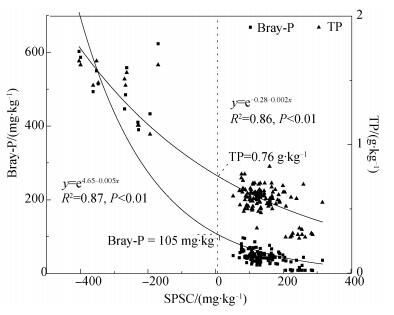
|
图 4 长期施肥的红壤旱地Bray-P、TP与SPSC之间的相关关系 Fig. 4 Correlations of SPSC with Bray-P and TP in the red soils under long-term fertilization |
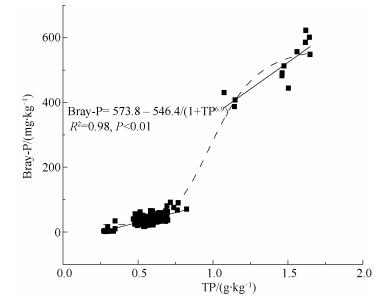
|
图 5 长期施肥的红壤旱地Bray-P与TP之间的相关关系 Fig. 5 Correlations between Bray-P and TP in the red soils under long-term fertilization |
SPSC是一个数量值,可以直接计算出在磷浓度超过环境风险阈值前,土壤可继续容纳与存储外源磷的容量[1]。SPSC = 0是判断土壤是磷的源或汇的转折点,当SPSC > 0时,土壤是磷的汇,即土壤不会向周围环境释放磷且可继续容纳外源磷; 当SPSC < 0时,土壤是磷的源,即土壤磷流失或浸出的风险将急剧增大[16]。本研究中发现,长期施用磷肥或配施作物秸秆虽显著降低了红壤旱地SPSC,但还未使土壤SPSC < 0,土壤仍是磷汇,土壤磷素是相对安全的; 而长期配施猪厩肥不仅显著降低了红壤旱地SPSC,且使SPSC呈现负值(-333 mg·kg-1),此时土壤磷极易向周围环境释放并污染水环境(图 1),这主要是由于猪粪的施用主要是以满足作物的氮素需求为标准进行的,由此就导致了外源磷的过量施入与大量累积,使得土壤中磷的吸附点位被迅速占据且在短时间内达到饱和或过饱和状态[17]。虽然,SPSC < 0时,土壤磷极易向环境释放,但也意味着土壤磷极易向作物根系移动并被吸收利用[18]。本研究中,长期配施猪厩肥的红壤旱地Bray-P高达483 mg·kg-1(表 1),远远高于作物利用最适的有效磷浓度20~40 mg·kg-1[19],可见,提高作物对土壤磷素的利用率也是有效降低红壤旱地磷素流失风险的重要方面。
各粒级团聚体是土壤磷素储存、转运及流失的重要载体,其磷素储存容量的大小直接影响着土壤磷素的环境安全[20]。长期施肥或配施有机肥可以显著降低红壤旱地中各粒级团聚体的SPSC,尤其是配施猪厩肥使各粒级团聚体的SPSC均呈现负值,由低到高依次为1~0.25 mm(-155.2 mg·kg-1)、> 2 mm(-86.0 mg·kg-1)、2~1 mm(-35.3 mg·kg-1)、0.053~0.25 mm(-33.1·mg kg-1)(图 2),这就意味着厩肥处理中土壤各粒级团聚体磷对环境均是不安全的,且极易向环境中释放。本研究还发现,长期施用无机肥与配施有机肥的红壤旱地中,对红壤旱地SPSC贡献率最高与最低的团聚体粒级均为1~0.25 mm与2~1 mm,而0.25~0.053 mm与 > 2 mm粒级团聚体的贡献率则相反(图 3); 由此可见,土壤团聚体的分布比例也是影响红壤旱地SPSC的重要因子,而长期施用无机肥或配施有机肥是调控红壤旱地团聚体组成的重要措施,尤其是长期配施有机肥可以显著提高 > 2 mm粒级团聚体分布比例,直接影响着土壤磷素的储存与供应效率[21]。
施肥是改善土壤团聚体结构,调控土壤磷肥力供应能力的重要措施[22],也是提高土壤DPS、降低SPSC、增加磷素流失风险的主要因素[23]。长期不施磷肥的NK处理,土壤磷素长期处于自然耗竭状态,SPSC高达265 mg·kg-1,土壤磷素储存容量较大; 长期施用无机磷或配施作物秸秆的红壤旱地SPSC均为正值且土壤仍具有容纳外源磷的空间; 而长期配施猪厩肥的红壤旱地SPSC呈现负值,土壤已无再容纳外源磷的空间、土壤磷极为不安全(图 1)。由总施磷量(TPFA)、土壤残留磷量(RP)与SPSC的相关方程可以推算出,当SPSC = 0时,TPFA =2 419 kg·hm-2,RP = 1 388 kg·hm-2(图 6); 那么,按照现有的年施磷量[14]计算,长期施用无机肥(NK处理除外)的红壤旱地仍可以继续安全施用磷肥30年; 而配施作物秸秆的PS、RS、FR处理仍可安全施磷41、30、14年,而低量施磷的CK处理则可安全施磷51年; 配施猪厩肥的PM处理应立即停止施磷或调整施磷量,不宜按现有施磷量继续施用。
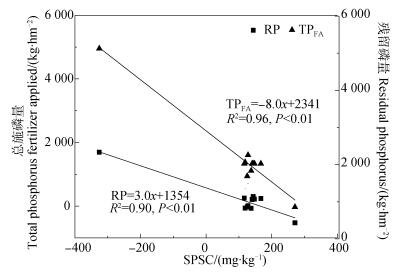
|
TPFA,总施磷量Total phosphorus fertilizer applied; RP,土壤残留磷量Residual phosphorus in the soil. 图 6 长期定位试验地各施肥小区总施磷量(1988-2014)、TP与SPSC之间的相关关系(总施磷量引自文献[14]) Fig. 6 Correlation between total phosphorus applied, TP and SPSC in the long-term field experiment from 1988 to 2014, relative to treatment |
SPSC的变化可以直接反映出土壤磷素的供应状态及其流失风险[3],因此,基于SPSC理论建立土壤磷素管控模式也是十分必要的。因此,与Nair等[16]的研究相结合,本研究构建了基于SPSC理论的红壤旱地磷素管理框架(图 7):即当SPSC > 10 mg·kg-1时,可以认为此时的土壤磷是土壤磷素是绝对“安全”的,土壤仍有储存外源磷的安全容量,若能提高土壤磷素的生物有效性或提高肥料的利用率,则可以有效提高作物的经济效益; 当-10 mg·kg-1≤SPSC≤10 mg·kg-1时,可以认为此时的土壤磷处于极度不稳定的状态,极易或已经开始向周围环境或水体释放,需要引起注意、定期监测,并及时调整施肥方案; 当SPSC < -10 mg·kg-1时,可以认为土壤磷已经向周围水体或地下水释放(具体迁移方向需要综合深层土壤进行讨论),应立即停止或减少施磷量,重新调整施肥方案,以降低环境风险,减少磷素资源的无效使用及浪费。
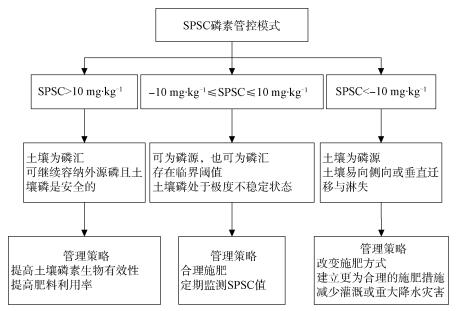
|
图 7 SPSC在红壤旱地磷素管理中的应用框架 Fig. 7 Framework illustrating the use of SPSC in P management in upland red soil |
长期施用磷肥或配施作物秸秆可显著降低红壤旱地及各粒级团聚体SPSC,但土壤仍具有容纳外源磷的容量(SPSC > 0),且按现有施磷量仍可安全施磷14~51年; 而配施猪厩肥的红壤旱地及大小团聚体SPSC均呈现负值,土壤磷极易向周围环境释放,应立即停止施肥或调整施肥量,不宜按现有施肥量继续施用。当SPSC > 10 mg·kg-1时,红壤旱地磷是绝对“安全”的; 当-10 mg·kg-1≤SPSC≤10 mg·kg-1时,红壤旱地磷处于极度不稳定状态,极易向或已经向周围环境或水体释放,需随时监测或停止施磷; 当SPSC < -10 mg·kg-1时,红壤旱地磷已经开始向周围环境或水体释放,应立刻停止施磷,并调整施肥方案。
| [1] |
Nair V D, Harris W G. A capacity factor as an alternative to soil test phosphorus in phosphorus risk assessment . New Zealand Journal of Agricultural Research, 2004, 47(4): 491-497.
(  0) 0) |
| [2] |
Nair V D, Clark M W, Reddy K R. Evaluation of legacy phosphorus storage and release from wetland soils . Journal of Environmental Quality, 2015, 44(6): 1956-1964. DOI:10.2134/jeq2015.03.0154
(  0) 0) |
| [3] |
Nair V D, Harris W G. Soil phosphorus storage capacity for environmental risk assessment . Advances in Agriculture, 2014, 2014: 1-9.
(  0) 0) |
| [4] |
Nair V D. Soil phosphorus saturation ratio for risk assessment in land use systems . Frontiers in Environmental Science, 2014, 2: 6.
(  0) 0) |
| [5] |
Abdala D B, Ghosh A K, da Silva I R, et al. Phosphorus saturation of a tropical soil and related P leaching caused by poultry litter addition . Agriculture, Ecosystems & Environment, 2012, 162: 15-23.
(  0) 0) |
| [6] |
Nair V D, Reddy K R. Phosphorus sorption and desorption in wetland soils[M]//DeLaune R D, Reddy K R, Richardson C J, et al. Methods in biogeochemistry of wetlands. Madison, WI, USA:American Society of Agronomy and Soil Science Society of America, 2015:667-681.
(  0) 0) |
| [7] |
Roger A, Sinaj S, Libohova Z, et al. Regional investigation of soil phosphorus saturation degree, a study case in Switzerland . US: CRC Press, 2014: 79-83.
(  0) 0) |
| [8] |
Hooda P S, Rendell A R, Edwards A C, et al. Relating soil phosphorus indices to potential phosphorus release to water . Journal of Environmental Quality, 2000, 29(4): 1166-1171.
(  0) 0) |
| [9] |
Nair V D, Portier K M, Graetz D A, et al. An environmental threshold for degree of phosphorus saturation in sandy soils . Journal of Environmental Quality, 2004, 33(1): 107. DOI:10.2134/jeq2004.1070
(  0) 0) |
| [10] |
Vadas P A, Kleinman P J A, Sharpley A N, et al. Relating soil phosphorus to Dissolved phosphorus in runoff:A single extraction coefficient for water quality modeling . Journal of Environmental Quality, 2005, 34(2): 572-580. DOI:10.2134/jeq2005.0572
(  0) 0) |
| [11] |
Dari B, Nair V D, Harris W G. Approaches for evaluating subsurface phosphorus loss potential from soil profiles . Agriculture, Ecosystems & Environment, 2017, 245: 92-99.
(  0) 0) |
| [12] |
张展羽, 王超, 杨洁, 等. 不同植被条件下红壤坡地果园氮磷流失特征分析. 河海大学学报:自然科学版, 2010, 38(5): 479-483. Zhang Z Y, Wang C, Yang J, et al. Characteristics of nitrogen and phosphorus losses in garden of red soil slope land under different vegetation measures (In Chinese). Journal of Hohai University:Natural Sciences, 2010, 38(5): 479-483. (  0) 0) |
| [13] |
吕玉娟, 彭新华, 高磊, 等. 红壤丘陵岗地区坡地地表径流氮磷流失特征研究. 土壤, 2015, 47(2): 297-304. Lv Y J, Peng X H, Gao L, et al. Characteristics of nitrogen and phosphorus losses through surface runoff on sloping land, red soil hilly region (In Chinese). Soils, 2015, 47(2): 297-304. (  0) 0) |
| [14] |
王经纬, 王艳玲, 姚怡, 等. 长期施肥对旱地红壤团聚体磷素固持与释放能力的影响. 土壤学报, 2017, 54(5): 1240-1250. Wang J W, Wang Y L, Yao Y, et al. Effects of long-term fertilization on phosphorus retention and release of soil aggregates in upland red soils (In Chinese). Acta Pedologica Sinica, 2017, 54(5): 1240-1250. (  0) 0) |
| [15] |
鲁如坤. 土壤农业化学分析方法. 北京: 中国农业科技出版社, 2000: 166-187. Lu R K. Analytical methods for soil and agro- chemistry (In Chinese). Beijing: China Agricultural Science and Technology Press, 2000: 166-187. (  0) 0) |
| [16] |
Nair V D, Harris W G, Chakraborty D, et al. Understanding soil phosphorus storage capacity . Soil & Water Science, 2016, 33(6): 1-3.
(  0) 0) |
| [17] |
马晓焉, 刘明, 李忠佩. 不同猪粪施用量下红壤水稻土表层水氮磷动态. 土壤, 2015, 47(2): 289-296. Ma X Y, Liu M, Li Z P. Dynamics of N and P in surface water of paddy soil in subtropical China under different rates of swine manure application (In Chinese). Soils, 2015, 47(2): 289-296. (  0) 0) |
| [18] |
Nair V D, Mining of soil legacy phosphorus without jeopardizing crop quality:Project directors meeting. Delaware:University of Delaware, 2018
(  0) 0) |
| [19] |
鲁如坤. 土壤磷素水平和水体环境保护. 磷肥与复肥, 2003, 18(1): 4-6. Lu R K. The phosphorus level of soil and environmental protection of water body (In Chinese). Phosphate & Compound Fertilizer, 2003, 18(1): 4-6. DOI:10.3969/j.issn.1007-6220.2003.01.002 (  0) 0) |
| [20] |
Yu C R, Gao B, Muñ oz-Carpena R, et al. A laboratory study of colloid and solute transport in surface runoff on saturated soil . Journal of Hydrology, 2011, 402(1/2): 159-164.
(  0) 0) |
| [21] |
Liu F, He J Z, Colombo C, et al. Competitive adsorption of sulfate and oxalate on goethite in the absence or presence of phosphate . Soil Science, 1999, 164(3): 180-189. DOI:10.1097/00010694-199903000-00004
(  0) 0) |
| [22] |
陈恩凤, 关连珠, 汪景宽, 等. 土壤特征微团聚体的组成比例与肥力评价. 土壤学报, 2001, 38(1): 49-53. Chen E F, Guan L Z, Wang J K, et al. Compositional proportion of soil characteristic microaggregates and soil fertility evaluation (In Chinese). Acta Pedologica Sinica, 2001, 38(1): 49-53. DOI:10.3321/j.issn:0564-3929.2001.01.007 (  0) 0) |
| [23] |
Nair V D, Chrysostome M, Harris W G. The long term contribution of phosphorus from agricultural lands to lake Okeechobee[2018-11-20].http://edis.ifas.ufl.edu2017.
(  0) 0) |
 2020, Vol. 53
2020, Vol. 53


